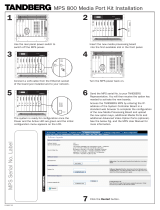
Revision F • 3/12
HARRIS CORPORATION
1-4
1 Product Overview
1.3 Warranty
Equipment Warranty Claims and
Procedures
1.
The Standard Equipment Warranty Period is
15 months from date of equipment shipment from
a Harris facility. The Customer’s sole and exclusive
remedy for any breach of the Standard Equipment
Warranty will be, at Harris’ sole discretion and
option, repair or replacement of the defective
Product. Components that Customer claims to be
defective must be made available to Harris for
inspection and evaluation. Unless otherwise
agreed in writing by Harris, Customs clearance
for all replacement parts under the warranty or
otherwise will be Customer’s sole responsibility.
To be entitled to rights under the Standard
Equipment Warranty, the Customer must notify
Harris in writing within thirty (30) days after
discovering a suspected defect in any Product or
Services, but in any event prior to the expiration
of the applicable Standard Warranty Period. Notice
to a Harris dealer, system integrator, sales
representative or other third party is not notice
to Harris. Following its receipt of any such
Customer notice, Harris will determine whether
the reported problem is covered by this Standard
Equipment Warranty. If Harris determines that
the problem is covered, Harris will authorize repair
or replacement of the defective Product, as
deemed appropriate by Harris in its sole
discretion. For clarification purposes, any technical
support provided by Harris will be for the sole
purpose of fulfilling Harris’ warranty obligations.
If Harris determines that Customer is using
technical support as a substitute for training of
Customer’s personnel, then such technical
support will be subject to additional charges at
Harris’ prevailing unit rate for such services.
2. Before shipping any Product to Harris, the
Customer must obtain a written Return
Authorization from Harris, and provide any proof
of warranty eligibility requested by Harris. Any
Product received by Harris without a Return
Authorization may, at Harris’ option, be returned
to the Customer collect. Once a Return
Authorization is obtained, the Customer is
responsible for packing and shipping the Product,
to which its warranty claim relates, to a service
facility designated by Harris, with all shipping
charges prepaid by the Customer, within thirty
(30) days after receipt of the Return
Authorization. Harris will pay for return of the
repaired or replacement Product to the Customer
if the repaired or replacement Product is shipped
to a designated Harris service facility. Harris will
use commercially reasonable efforts to supply
Equipment (or part thereof) from the geographical
region of Customer’s site, so as to minimize
freight and duty. Harris bears the risk of loss or
damage while the Equipment (or part thereof) is
in transit to Customer from the Harris Service
Center, and Customer bears the risk of loss or
damage while the Equipment (or part thereof) is
in transit back to the Harris Service Center.
3. Upon receipt of replacement Equipment (or
a part thereof), Customer has thirty (30) days to
tender the defective Equipment (or part thereof)
to the return carrier for shipment to the service
center designated by Harris. If Customer does
not timely return the defective Equipment (or a
part thereof), Harris shall invoice Customer for
the list price of such Equipment (or part thereof),
plus applicable shipping. Such failure to return
the Equipment (or part thereof) may, in Harris’
discretion, be grounds for termination of the
Warranty and/or suspension of any future
advance exchange privileges until such
outstanding defective Equipment has been
returned. Under the Standard Equipment
Warranty Harris will provide Customer with new,
rebuilt, refurbished or alternate Equipment (or a
part thereof) of equal or improved quality, as the
exchange Equipment (or part thereof) to replace
eligible defective Equipment (or part thereof). Any
alternate Equipment (or part thereof) will meet
or exceed the specifications of the replaced
Equipment (or part thereof). Rebuilt or
refurbished Equipment may bear cosmetic
blemishes that do not affect performance. Unless
otherwise specified by Harris in writing, repaired
or replaced Equipment (or parts thereof) are
covered only for the remainder of the term of
the applicable Standard Equipment Warranty. All
defective Equipment (or parts thereof) replaced
by Harris become the property of Harris. Harris
has no obligation to (i) service, exchange or
otherwise replace any Equipment (or part thereof)
that has been damaged, modified, abused,
misused or overused as determined by Harris or
has been used with non-Harris supplies or
products that have caused damage or
malfunction; (ii) paint, refinish, refurbish, restore
or exchange any Equipment (or part thereof) with
cosmetic blemishes; (iii) service, exchange or
otherwise replace any Equipment (or part thereof)
if the same would interfere with, impede or be
redundant with normal or scheduled maintenance
of such Equipment (or part thereof); (iv) service,
exchange or otherwise replace any Equipment
(or part thereof) that is within sixty (60) days of
the end of its production life; or (v) provide any
application software support or service involving
application hardware or replace any accessories.
If Harris elects to perform any such services at
Customer’s request, then such services will be
deemed a service call and all labor, parts and
materials used for the service call will be charged
at Harris’ then-prevailing rates.
Equipment Warranty Exclusions
Harris does not warrant nor guarantee, and is
not responsible for:
1. Defects, failures, damages or performance
limitations caused in whole or in part by (A) power
failures, surges, fires, floods, snow, ice, lightning,
excessive heat or cold, highly corrosive
environments, accidents, actions of third parties,
or other events outside of Harris’ control, or (B)

























